Finding Heart: 2019 Cascade Crest 100 Race Report
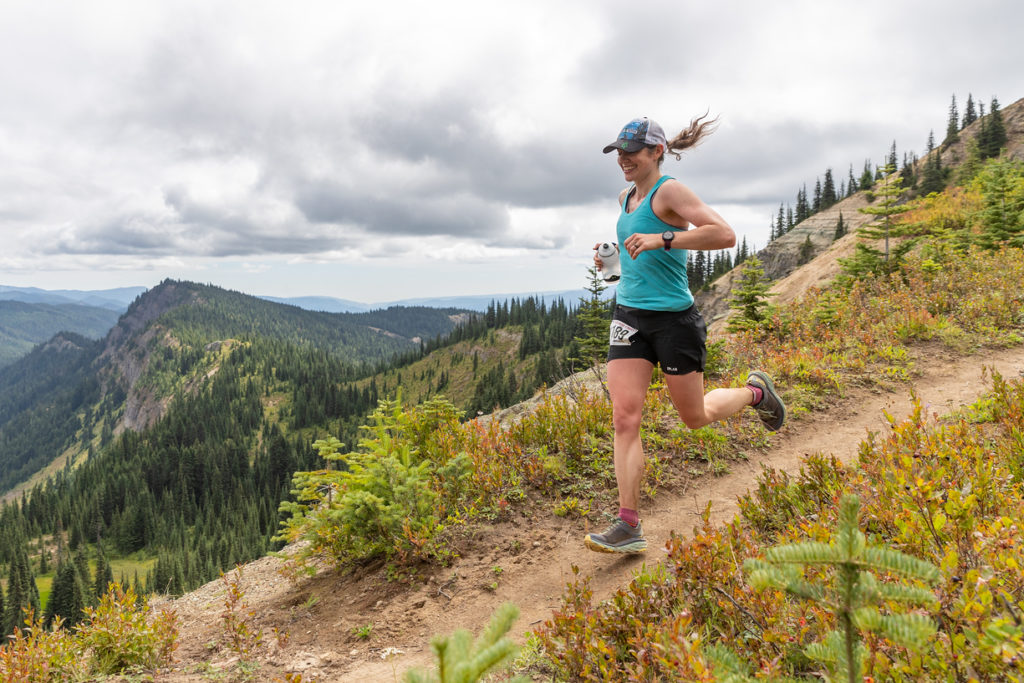
Sometimes it seems that the more I run, the less I write—both pursuits require muscle, and muscle requires consistent exercise to maintain; there are only so many hours in the day, and for the past three years, I’ve given running most of the free ones. This can feel like an acceptable (temporary) tradeoff until moments like this when I have a thousand things I want to say, and no idea how to begin putting them into words. The blank page, like the opening of an ultra, can exhilarate and terrify me in the same breath.
The week leading up to this year’s Cascade Crest 100 had been unusually heavy with the sorts of life stressors and stormy emotions one always hopes to bag up and ditch at the start line. For days, my heart rate had been pounding, and no amount of sleep or meditation or reductions in coffee consumption seemed to calm it. Race morning brought no respite. I’d tossed and turned all night, and in the morning, my watch let me know that my “Body Battery” (which estimates, on a scale of 1-100, my energy level at any given moment based on physiological factors like heart rate variability, stress, recent sleep quality, etc.) was at 37. (Normal mornings clock me in at 90-100 upon waking.)
I tried not to think about any of this and instead just feel grateful for the family-reunion vibes that race morning at Cascade always brings. The sun was shining bright on Easton, and I soaked up the hugs with old friends. At the firehouse, I felt restless. When the 9 a.m. start rolled around, I sighed with relief.
At last, we would run. In many ways, the easy part.
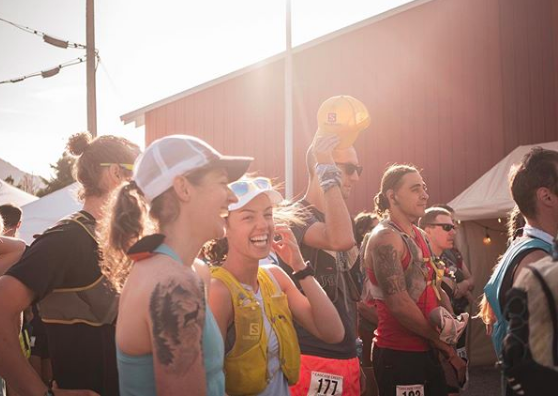
But as we all trotted out of Easton and away into the mountains, the emotions I’d hoped would disappear with a whoosh when the race began instead followed me, nipping at my ankles as I jogged. I watched, with unexpected ambivalence, as the fast ladies rocketed away from me.
Part I: Patience
Just a few days earlier, I’d attended a wonderful seminar put on by my friend, Trisha Steidl, about mental strategies for training and racing. She’d suggested choosing three words before a big race—one to focus on for each third of it. The three I chose for myself for Cascade this year were:
- Patience (first third)
- Resilience (second third)
- Heart (last third)
So, patience it was. Still, my heart rate was bonkers on the first climb up Goat Peak, and my mind felt like a rusty old appliance doomed to fail at the day’s mission. Some time after we’d crested the first climb and began running back down, I stole a glance at my watch and was horrified to see my heart rate hammering away at 176. That is maybe what it gets up to when I’m redlining up Mount Si during the final minutes of a hard threshold workout—not what it should be on a chill, flowy descent less than a tenth of the way into a hundred-miler.
I pondered DNFing, briefly, before deciding it’s dumb to make decisions based on a piece of plastic on my wrist. So I vowed to stop looking at my heart rate, just run easy and think, Patience, patience, patience.
Plus, Cascade was my A race this year; I’d trained my butt off—not just physically, but mentally, emotionally and spiritually, too. (Sure, physical training mattered, too; more on that later.) When my coach and husband, George, asked me at the beginning of this season what I thought I needed to do to be able to improve on my time at Cascade last year, I’d said something to the effect of, “I don’t know, get leaner?” I had trained and worked so hard last year to finish in 23:03 on what had felt, at the time, like a nearly perfect day; I couldn’t imagine what further improvements I could still glean at the margins.
But George saw all sorts of opportunities—ways to analyze my splits from last year and figure out where I’d lost the most time, ways to more meticulously plan out my race/gear/nutrition/hydration (not my usual M.O.), and, above all, ways to better prepare my mind. Not just to finish—I’ve never had trouble finishing—but to race. To not let myself get intimidated in the face of competition. To run with confidence.
I soon fell into step with Julia German from Boulder, who was a delight. Sharing miles and conversations with her yanked my mind out of its initial pit of dwelling/rumination and firmly into the present moment—the towering trees, the blue sky, the footprints in the dusty trail ahead, the beautifully simple task of putting one foot in front of the other, over and over and over again.
I’ll quote my friend Jenn Hughes here, who once described 100-milers as vacuum-packed Ziploc bags: “Once the gun goes off, you enter the bubble. Empty gas tanks, unanswered emails, dirty laundry, and the electric bill … they begin to fade in the protected confines of the race. The noise grows quiet and your to-do list becomes succinct. Food, feet, what hurts, big hill, chafe, check the watch, next aid station. A Rolodex of tasks propelling you toward the finish. And then, after enough hours, when you are deep in the rhythm, you realize that all the little jobs have gelled together into one simple purpose: move forward. And there we find it … the peace we crave so deeply. The monkey mind is gone, the clutter is washed away, our path is clear.”
I was grateful to have ditched my monkey mind somewhere around Cole Butte. Not long after, on the next climb, Julia and I caught up to Tara Fraga, who stepped aside to let us pass. Having shared (enjoyed!) many miles with Tara at various races over the past two years, I pushed her back onto the trail in front of me and said, “Nope, you’re coming with us!”
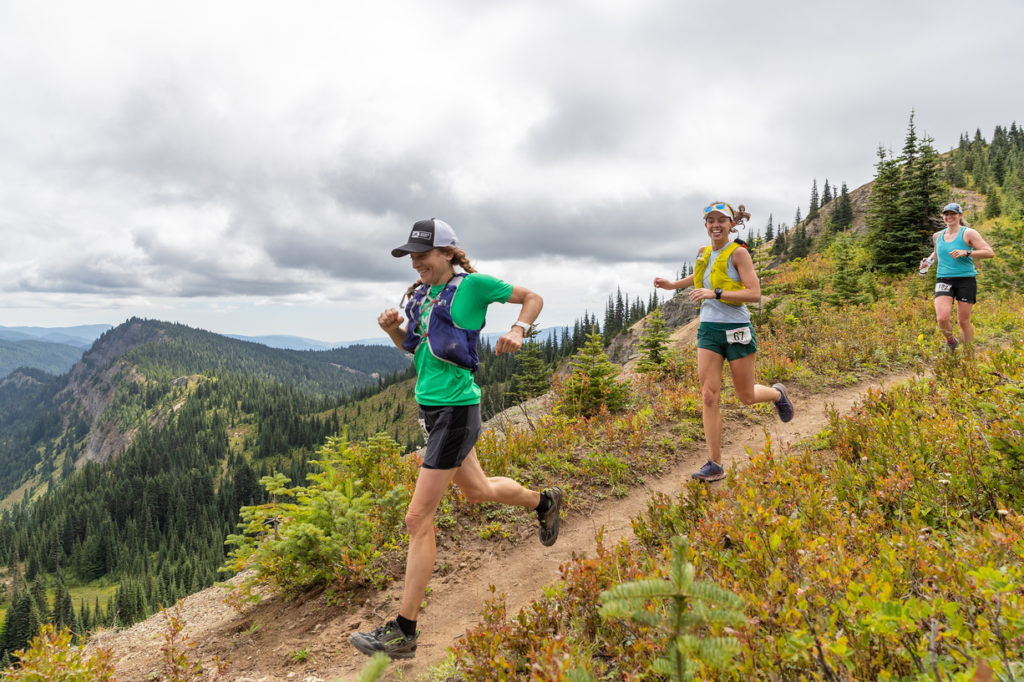
Perhaps I did so because, in that moment, I recognized myself in her—the part of me that had led Sun Mountain 50 last May for two-thirds of the race before Monique van den Boogaart danced by and left me in the dust. The part of me that had led White River 50 in July for a dozen miles before Christine Mosley caught up to me and led me in a crusher six-mile sprint down from Sun Top (a week after she won Vermont 100, no less!) that left me with nothing with which to do battle on the remaining six miles through Skookum Flats. The part of me that, just an hour earlier, hadn’t quite yet made it into the magic, vacuum-packed Ziploc of Cascade Crest. But now I had, and I wanted Tara to be in it, too—in part out of a genuine desire for her to have a positive experience at her first 100, and in part for more complex reasons.
One of the things that had excited me most about Cascade this year was the depth of fast women who’d gotten into the lottery. But over the course of this year, one by one, many women pulled their names from the entrants list. There were certainly still many badasses present (as an illustrative point, my winning time last year would have only earned me 5th place among women this year)—but with this year’s original herd somewhat thinned, I sincerely wanted everyone who toed the start line on Saturday to have a great day out there. The better they ran, the better it would force me to run.
After all, a rising tide lifts all boats.
Embracing this positive aspect of competition was really a new thing for me this year. Listen, trail running has plenty of aspects that make it easy to love: nature, snacks, awesome humans. Competition is generally a less lovable (or, at least, less loved) aspect. When coach George told me that I needed to learn how to make peace with competition, I thought, No, no, no. That’s not what trail running is about. Please just let me continue being in it for the snacks.

But I worked on that attitude this year. The shorter races I ran taught me a lot. I learned that it is possible to separate competition from ego; that winning or “losing” doesn’t always feel that different, as long as you know in your own heart that you gave something your all.
I also came to appreciate that one of the positive aspects of competition is the additional mental focus it demands. It is hard to meditate in a storm. Those 50-milers, plus Chuckanut 50K back in March, helped me practice staying calm when my mind demanded that I panic.
That is a useful skill for regular life, too.
Part II: Resilience
Tara and I would pretty much run the next 40 miles together. Sometimes we were chatty, and that was delightful. Sometimes we got quiet, put our heads down and just worked hard—and that was delightful, too, in a different way. We caught up to Kim Magnus and the three of us ran the trail down into Stampede Pass (mile 36.2) together, chatting away the whole time. I treasured their company.
All along the PCT, I thought of the other awesome women with whom I’ve shared this stretch of the trail in the previous years that I’ve run Cascade—Jade de la Rosa in 2016 and Jennifer Love last year. Cascade is the first and only 100-miler I’ve ever gone back to run more than once; though it’s always fun to go explore new trails, there is also something magical about returning to the familiar.
Tara and I finally bid the PCT farewell, picked our way down the ropes and hit the John Wayne Trail. We fell into a fast clip, side by side, going through the Snoqualmie Tunnel. I think neither of us was sure who was setting the pace, but whoever was, it was not slow! Those miles passed to the tune of water drips echoing in the tunnel and the rhythmic sounds of our footsteps and our breathing. Toward the end of the tunnel, we heard voices. We cheered and whooped, and could hear the voices at the end musing over the suspense of which two women were about to pop out of the tunnel; all they could see in the darkness of the tunnel were our headlamps.
“It is just me, or did we just cook through that tunnel?” Tara asked me, laughing.
I responded with some kind of slightly breathless but exhilarated affirmative.
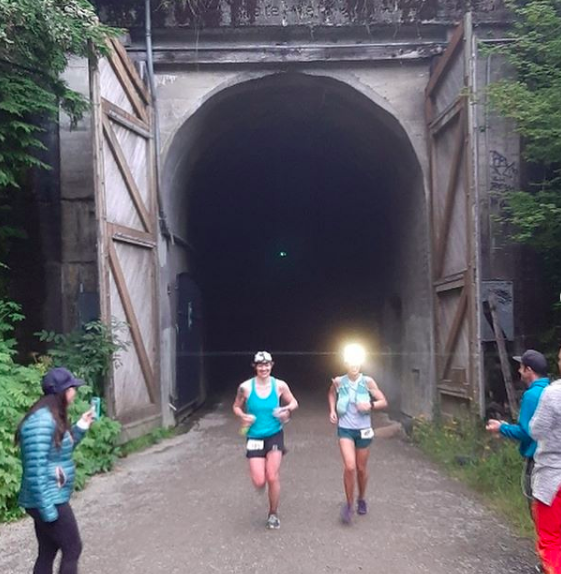
We flew back out into the daylight and high-fived Rich and Adam and Wendy and the others gathered there on our way to the aid station at Hyak (mile 54.3). Because we’d both be picking up a pacer there, we knew we probably wouldn’t continue running together from here on out. We thanked each other for the shared miles and wished each other a good race through the night.
Here, Trisha would join me as my pacer for the next 23 miles. She was wonderful and everything I needed on the next stretch. She provided some measure of distraction from the effort at hand as we, too, shared conversations under the starlit sky and gold sliver of a moon. I mean, is there anything better in life? I don’t think so. Getting to share long, lovely hours in the woods with other humans is what made me fall in love with this sport in the first place—and perhaps the fact that I now do a lot of my training solo and on a treadmill only makes such moments all the richer. (Don’t get me wrong; I get a lot of enjoyment out of solo workouts, too, even those on the treadmill. But nothing compares to sharing the outdoors with a fellow good soul.) With Trish at my side, I was deep in the headspace that has always been like rocket fuel for me at races—grateful, free from ego, connected to others, and 100% present.
Always, in these moments, I wonder: How do I bottle this up and take it home with me?
Trisha also kept me on point, helping me run efficiently and push the pace whenever I started to get too relaxed and chatty. (Disclaimer: I was pretty chatty. Singing was involved.) At one point, she said, “OK, I’m sorry but I’m going to be a bit of an asshole now and say that I think you can probably hike faster than you are.”
She was correct. I’m not an especially good power-hiker; I prefer to run whenever possible. (Props to George, again, for teaching me how to run uphill more efficiently than I’ve ever been able to power-hike.) So I quit my lollygagging and started running again. We hunted headlamps on the dark road ahead and passed a few dudes during this stretch. We cruised through the Keechelus Ridge aid station (62.4) and bombed down the other side. My last big workout, six days before the race, had been hard downhill repeats on the East Tiger service road; it had been a miserably tough workout, but now my quads were singing hallelujah all the way to Lake Kachess (mile 69.2).
The Trail from Hell seemed less hellish than years past. Last year I’d been hobbled to a crawl through here due to temporary but intense pain in my knee. This year, the trail flew by and I loved it. The creek crossings refreshed my tired feet. The woods were quiet and there was no one else in them—at least anywhere near us. I relished the solitude, and before I knew it, we had blown through Mineral Creek (mile 75) and made it up the road to where George would take over as pacer.
Part III: Heart
I couldn’t wait to get up to No Name (mile 81.6)—my favorite aid station at Cascade, since it’s run by so many of my longtime, veteran ultrarunner friends. Arriving there and getting hugs from Matt and Deby and so many others was sweet as ever. George and I charged right on through, though, and soon caught up to Jeason Murphy, whom I hadn’t seen since I left Colorado in 2016. He’d run some inadvertent bonus miles in the night, so understandably was feeling a bit low, but told me, “Well, if I were going to get passed by anyone at this point in the race, I’d want it to be you.” We wished one another well. On the way down from Thorp, we passed Glenn, who was hiking up in the dark to his usual post there to take photos of the runners.
At French Cabin (mile 89.2), I did some math and determined that I was within striking distance of the finishing times—21:15 and 21:15:55—of two women who have been huge personal inspirations to me—Darcy Piceu (2007) and Shawna Tompkins (2011). The finishing times at Cascade over its 21 years are not totally straight comparisons due to the course getting lengthened by several miles in 2016. (Notably, too—and I point this out because Kaytlyn isn’t the type of person to draw attention to this herself—Kaytlyn Gerbin’s winning time in 2017 was on an even longer, harder, one-year-only alternate version of the new course, due to wildfires that year—so it’s in a bit of a league of its own.)
I was still nowhere near Alissa St Laurent’s mind-boggling 2015 record (19:25) on the old course, but somehow, the idea of finishing Cascade—in whatever iteration of its course—in the same amount of time it had once taken Darcy and Shawna filled me with a sense of connection to these women. Along with Krissy Moehl and Jesse Lang and Jeremy Humphrey and Jeff Browning and Rod Bien and so many others who have won this race in years past, Darcy and Shawna in particular are people whom I have long admired—as much for their racing accomplishments as for who they are as humans. For their thoughtful approach to life, for not defining themselves solely by running or external validation, for not needing to parade around their own accomplishments, but just putting in the work day after day, showing up and getting things done. In the current social-media landscape that encourages constant self-promotion, I’ve come to admire traits like humility, diligence and quiet consistency all the more. (Getting to work on this in-depth story about Shawna, who embodies all of those qualities, has been one of my highlights of the last year. I’m honored to call her my friend now, too.)
Last year, it took me exactly 2 hours and 7 minutes to run from French Cabin (mile 89.2) to the finish. I’d run it hard. I also knew that it usually takes the top men about 2 hours and 2-4 minutes to run that section. By my math at French Cabin this year (there is nothing more fun to do during an ultra than math!), I determined that if I could just run the final section in 2 hours and 5 minutes, I could squeak under 21:15.
The race was on. I mumbled something to George about the fact that I was now racing the imaginary ghosts of Darcy and Shawna and, in a way, my own self from last year—but when we talked about this long after the race was over, I learned that George hadn’t heard/understood anything I’d said here. (Haha!) He did, however, notice the freshly kindled fire in my legs.
As some final bedtime reading the night before Cascade, I’d reread a chapter in Matt Fitzgerald’s How Bad Do You Want It? Mastering the Psychology of Mind Over Muscle about Sammy Wanjiru’s unbelievable win at the 2010 Chicago Marathon. Carey Pinkowski, the Chicago Marathon RD, later concluded, “Sammy proved his heart today”—and Fitzgerald uses the story to illustrate that, in sports, “heart” is a metaphor for mental fitness. I thought of this chapter as I ran the last 10 miles of the race and silently recited my mantra: Heart, heart, heart.
The runner-pacer relationship between George and me is a pretty well oiled machine by now; we’ve done a lot of these things together over the years. In general, we didn’t talk much other than him telling me “Great work” here and there, or reminding me to take a salt tab. I hadn’t shared my three words with George beforehand, but the universe vibes must have been flowing, because sometime after we’d passed through French Cabin and I’d clearly begun smelling the barn, he growled, “YES! That is the heart of a champion.”
The last mile and a half is on the road back into Easton. Trisha ran out to meet us and run in the last stretch with us. She was excited. George was excited. I was excited, but working way too hard to be able to talk or smile or do anything other than run and occasionally let out a small whimper of exhaustion. How sweet that finish line would feel!
I was going to miss Darcy’s time by a minute and a half and Shawna’s by 30 seconds, but ultimately that didn’t matter; I knew I’d given it my all. To feel that I’d gotten to share a race with my heroes—the ghosts of my veteran idols, as well as my newer heroes like Tara (who, on a side note, did cover that final stretch in a blistering 2 hours and 5 minutes!) and Kim and Julia and Jeason and Kat (Schuller) and Spencer and so many others I’d shared some portion of the course with this year—was reward enough.
I crossed the finish line in 21:16:26. Just like the beginning, I felt two things in the same breath—exhilaration and terror. My body was happy to be done, but my mind wasn’t quite ready for it to be over. It had been such a special race, after all.
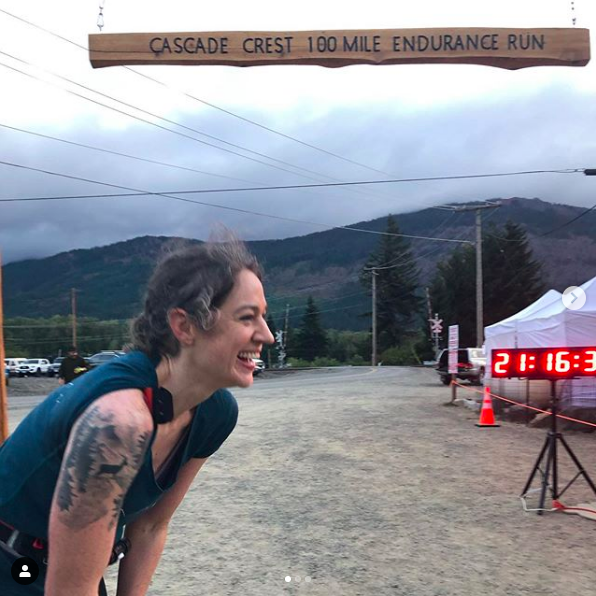
Part IV: Notes
After the race, my friend Sarah Lavender Smith texted me to congratulate me and ask whether I’d done anything differently in training this year.
Lord, yes. That’s another blog post entirely. In short, I will say that I credit my husband, George Orozco, with coaching me for the past three years and continually pushing me to challenge my own self-perceived limits. He puts together amazing training programs for a small cadre of athletes, and I feel like we’re all lucky bastards. (He also coaches our buddy, Richard Lockwood, who ran a smoking 19:05:15 for fourth place overall at Cascade this year.)
Consistency in training goes a long way. George’s emphasis for all his athletes is on hard, high-quality workouts, strength training, and low-volume mileage—honest to God, I averaged maybe 30 miles/week all year, and I can count on one hand how many runs I did all summer that exceeded four hours. His approach is perfect for busy bees like me who cram training in around a 9-5 job and kiddos.
Additionally, we moved this summer and I began bike-commuting a few times a week (though only about a month before Cascade, so who knows whether that had any appreciable impact or not). I ate more protein this year to support the additional strength training I incorporated and, in general, was more intentional about my day-to-day nutrition. (I still eat a not-insignificant amount of junk food; it’s just complemented with a lot of complex carbs, fruit, vegetables and lean protein.) That’s the physical side of it.
George was right to tell me at the beginning of this season that the rest of it really is mental. That there would be value in learning to embrace competition instead of recoil from it.
Of course, competition is a double-edged sword. I hated (and promptly quit) track after two seasons in middle school. I then spent many years shit-talking that particular sword, mostly because I couldn’t stand that something as meaningless as a footrace had the power to sometimes make me feel terrible about myself. Even if/when I won, I resented the emotions that came with victory, for they seemed shallow, ego-driven and dependent on the failure of others.
This year, for me, has been about appreciating the other side to that sword—where competition is not a means for satisfying (or tempering) the ego; in fact, it really has nothing to do with it. Rather, it is a tool to sharpen the mind. In this way, it’s easy to see other runners as partners rather than adversaries. Coconspirators on the quest to become the best versions of ourselves.
Congratulations to everyone who toed the line at Cascade this year. Thank you to George and Trisha for being there for me, and to everyone who supported me and my race, including friends and family “watching” from afar. Thank you to Rich, Adam, Wendy and all the volunteers who make this event so very special year after year. Finally, thank you to all the other runners this year—especially Tara, who absolutely killed it at her first 100-miler, and helped push me to do more than I thought I could.
The people are, and always have been, what bring meaning to these wild endeavors.
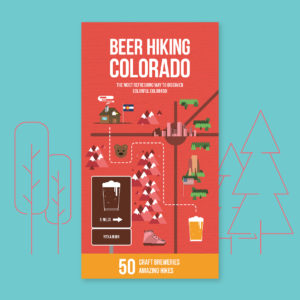
[…] —Yitka shared her story about her recent win at Cascadia Crest. Excellent read that digs into the mindset, pacer relationship, comparisons to others, humbleness, etc. Great. piece if you’ve got a few minutes to spare. […]
Yitka, I adore reading everything you write. I feel so much emotion from your words and am so impressed with your planning and execution and rising above the excuses that could have been present. Thank you for sharing such an amazing experience with us. Well done!!
Elaine, I am nearly a month late in responding to your comment, but thank you very much for taking the time to read my blog and for your kind words here. They mean a lot! Hope to cross paths again soon.
ditto to the previous comment. Taking the time to read your writings is always worthwhile. Thank you so much for taking YOUR time to put this race into words. Congratulations on the many successes of the day.
I’m currently struggling with the “low battery/high HR” issue. Your openness about the same situation, and how you chose to not let it rule your race day, really resonated with me.
Thank you, and congratulations, again.
Jennifer, thank you so much for taking the time to read and comment! I really appreciate it. Heart rate can be a tricky one to wrangle, but I hope you sort things out or, at the very least, indeed figure out how not to let numbers call the shots come race day. (Or even on training runs!) This experience was definitely an eye-opener for me in not taking my watch’s stats (or even my mind’s early projections/anxieties) as gospel, and sometimes just putting what feels like blind faith into myself, the training I’ve done, and the possibility for any day to turn out way better than imagined. 🙂
Heart! Such a great read. And your ability to focus in the latter part of long runs is really admirable.
Thank you for the kind words, Martin!
Yitka, your race report was such an adventure to read as it encapsulated so much emotion and the reality of your journey this year from your training through the race to the finish line. I find a learn so much from seasoned trail runners like yourself that hold tightly to the grit and heart of the sport while cheering on fellow women to dig deep and rise to the challenge. You are one of my trail idols with your big smile and gentle spirit. Thank you for sharing about your journey! Much kudos and congratulations to you and your accomplishments at Cascade Crest! It was so exciting to see you crush your own time from last year.
Nicola, a long overdue thank you for your wonderful thoughts and generous words here. I feel both touched and honored! I am so sorry that your fall/injury earlier this year got in the way of you running Cascade this year, too 🙁 but please know how much I have admired your positive attitude throughout that whole experience and healing journey. Keep staying strong, and I know we will soon see you crossing the finish line at Cascade. Hope Oregon is treating you well, and hopefully we can share some trail miles one of these days, too!